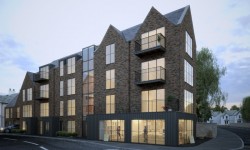You don’t need to be an industry insider to know there is a chronic shortage of housing in the UK. Oliver Lowrie, Co-Founder and Director of architectural practice, Ackroyd Lowrie explains why volumetric modular construction could provide several answers.
The government has pledged to deliver one million new and affordable homes by the end of 2020 – a tall order given that only 184,000 were built in 2016-17. Productivity is on the up, and whilst that is cause for celebration, it is still only marginal. As an industry, we are pressured to provide 300,000 new homes each year to meet the goal of one million. Meanwhile, every heavy industry is facing the same challenges at the core: reduce waste, drive efficiency and reduce the carbon footprint.
In 2015, only 69% of projects were completed in budget and only 40% were completed on time, exacerbated by an aging population, insufficient training and a declining population of skilled, onsite labour. As the population grows and requirements develop, so too must our provision of services and crafts.
As homebuilders, we are in a position to introduce a truly disruptive solution to the construction industry’s key challenges and also the social and economic issues fuelled by the housing crisis. ‘Modernise or die’ was the conclusion of the Farmer Review which assessed the state of the UK construction industry in 2016. Volumetric construction does just that and as such, adoption is growing in the UK. However, as is often the case, we have been fairly slow at seizing opportunities. Currently 15,000 volumetric homes are built each year in the UK. In contrast, our international counterparts are really beginning to maximise opportunities presented by volumetric construction and are driving creativity in every aspect of the design and build processes. In Japan, a quarter of homes are built offsite and in Sweden, more than 50% of all new detached homes are prefabricated. Volumetric housing is a quick, highquality, cost-effective offsite technique where entire blocks of apartment or homes are pre-manufactured in factory conditions. They are produced in a series of ‘volumes’, which are
then transported to the site to be assembled and stacked, rather than ‘built’.
After drainage and foundations are laid, the entire building can be craned into place in modules. Less affected by poor weather conditions, onsite labour and supply chain delays, volumetric construction allows developers to deliver homes ‘just-in-time’ and with uncompromised quality. The volumes can be pre-clad and include windows, with kitchens, bathrooms and even furniture pre-installed at the production location. Internal and external finishes can be installed in the factory where quality can be monitored effectively.
The legacy of post-War social housing haunts offsite construction, but advances in both the BIM modelling software used by architects, and the manufacturing capabilities of modern offsite fabricators means that beautiful, bespoke projects can be delivered in a streamlined way. At Ackroyd Lowrie, we use virtual reality headsets to allow our clients to explore a series of different options. These are then developed into a final proposal which is fully signed off by the client before being sent to the manufacturer for production. 70% of rework on all construction projects can be attributed to onsite redesigns, which can cause major delays, we can be hugely expensive in terms of time and financial spend, as well as being hugely wasteful in terms or materials and energy.
Without factoring in the avoided delays of traditional builds, the volumetric route is still far quicker than onsite construction. So, whilst the housebuilding industry is not renowned for being particularly innovative, in offsite, volumetric housing we are confronted with something that will revolutionise the way we build homes and make a significant dent in the housing numbers we desperately need. Driving further adoption will only increase confidence, improve profitability and level the playing field for innovation in the property sector.
To read this article in Offsite Magazine please visit: Offsite Magazine
For more information visit: www.ackroydlowrie.com









